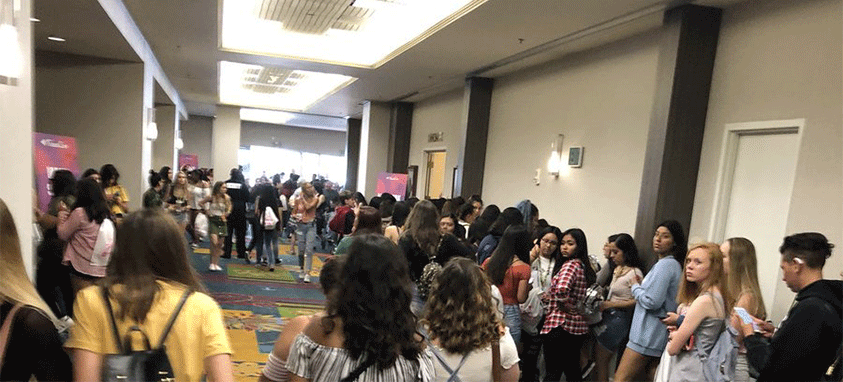If you haven’t heard of TanaCon, the next generation of event planners certainly has—and TanaCon is a case study in what can go wrong.
To understand what went wrong, let’s rewind.
TanaCon was birthed from a dispute between Tana Mongeau, a YouTuber with 3.5 million subscribers, and VidCon, a conference dedicated to video platforms such as YouTube and its content creators. VidCon offers young fans a chance to meet their favorites. The convention boasts more than 20,000 attendees at Anaheim Convention Center and has been held there since 2012.
Mongeau, 20, had not been given a Featured Creator badge for previous VidCons, resulting in her being swarmed by fans everywhere she navigated in the convention. (Featured Creators get access to nonpublic service hallways in the convention center, preventing just that.)
In April, Mongeau retaliated by announcing her own VidCon-esque convention, calling it TanaCon. It was to take place during VidCon in Anaheim—in fact, right across the street at the Marriott Anaheim Suites. She promised a focus on the fans, with long meet-and-greets with famous YouTubers and an affordability that VidCon couldn’t match: while VidCon charges $150 for entry, TanaCon was free for those who registered in May; VIP passes were only $65.
The VIP passes were supposed to allow attendees to skip lines, have private meet-and-greets and get swag bags that would be “worth more than quadruple the price of the whole ticket,” Mongreau tweeted in May, when TanaCon was less than a month away.
https://twitter.com/ashleyfoster09/status/1010271671394000901
The convention-created-out-of-spite culminated in about 4,000 young fans standing in the hot Southern California sun for hours, waiting their chance to enter TanaCon. Just over 1,000 attendees made it inside the venue, maxing out the capacity of the main ballroom and a small room dedicated to merchandise sales. Outside, a crowd of mostly teens and tweens, alongside their parents, became increasingly sunburned and dehydrated. The chanting for refunds began.
Since all attendees were channeled into the same line—even if they paid for the VIP pass—the chaos resulted in the Garden Grove Police Department being called by the hotel to assist with the unruly crowd. Videos online showed a stampede of teens. One girl was taken to the hospital for minor injuries. The Garden Grove Police Department released a statement not only to explain what occurred but also disputing the 15,000 people Mongeau touted as being in attendance.
After a few hours, the event was canceled for the day, and the crowd was dispersed. Efforts to relocate to a bigger venue for the rest of the planned three-day event were not successful. Good Times Entertainment, the company hired to mount and manage the event, released a statement saying the sheer number of fans who showed up—a 15,000-person crowd, it said—compromised the safety of the event. TanaCon was canceled. Good Times promised refunds within 30 business days.
While some outlets have been reporting that TanaCon took place at Marriott Anaheim, the convention actually occurred at Marriott Anaheim Suites, which has event space clearly listed on its website with a maximum capacity of 1,018 attendees and a total of 9,727 sq. ft.
Veteran YouTuber Shane Dawson covered this issue extensively, interviewing all sides—including 21-year-old Good Times Entertainment CEO Michael Weist—on, fittingly, YouTube. You can watch the saga here.
The disastrous TanaCon reminds us all how much challenging work goes into event planning, especially within a three-month timespan.
Here are our takeaways:
- If it’s free, plan big
Free events need a larger space that can be scaled down if needed—could this be why a lot of free events are outdoors? Find venues with adaptable space that can accommodate more people than you expect but can also be made to seem “big” with a smaller crowd.
- Don’t underestimate your influencers
Content creators have loyal, dedicated fans—many whom sacrifice to attend. Influencers, while embracing their communities and relationships with their fans, should be aware of the clout they have and take that into account if planning events. Plan larger, especially, when influencers have younger fans.
- Security, safety and well-being are Priority No. 1
Separate lines for paid attendees and free attendees are important. TanaCon skipped bag and security checks—a huge no-no. Attendees should feel safe, secure and welcome in the venue. A lack of organization and order for registration is impossible to manage on the fly. Having an event app for attendees to check-in quickly would have come in handy, but it wouldn’t have solved everything. Make sure the area is secured, and all bags are checked.
- Visualize far in advance
Three months is simply not enough time to plan a three-day event on this scale. If TanaCon had been pushed to 2019, something a little closer to Mongeau’s vision might have been achieved. Utilize timelines and deadlines to get on track, especially if you’re crunched for time. For an event of about 5,000 people, allow at least six months—a year is better—of planning.




